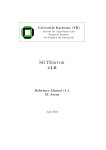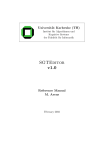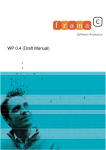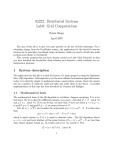Download as a PDF
Transcript
Solving Systems of Affine (In)Equalities: PIP’s
User’s Guide
Paul Feautrier
Additions by Jean-François Collard and Cédric Bastoul
Fourth Version, rev 1.5, November 8, 2005
Abstract
This document is the User’s Manual of PIP, a software which solves
Parametric Integer Programming problems. That is, PIP finds the lexicographic minimum of the set of integer points which lie inside a convex
polyhedron, when that polyhedron depends linearly on one or more integral
parameters.
1
Introduction
The semantic analysis of programs accessing arrays often boils down to finding
integer solutions to parametric linear programming problems. This is due to two
main phenomena:
• Array subscripts are very often linear functions of surrounding loop counters ;
• The program’s execution order enforces an order on possible solutions.
Let us consider the following example:
for i:= 0 to m do
for j := 0 to n do
a[2*i+j] := i+j;
{I}
After completion of execution, for which values of k is A[k] defined, and which
instances of the assignment wrote into this array element? We can easily check
that answering this question is equivalent to finding the solutions of the following
system, where i, j and k are the unknowns:
0 ≤ i ≤ m,
0 ≤ j ≤ n,
2i + j = k.
1
(1)
(2)
(3)
2
2 USING THE PIP SOFTWARE
Moreover, if we want to know which instance gave its final value to A[k], that
is if we are looking for the last instance writing into A[k], then we have to look
for the maximal value of vector (i, j) according to lexicographic order. We thus
consider the following polyhedron F (k, m, n):
F (k, m, n) = {< i, j > |0 ≤ i ≤ m, 0 ≤ j ≤ n, 2i + j = k}.
(4)
What is the lexicographical maximum of the integer-valued vectors included in
F (k, m, n)? The aim of PIP is to solve such problems. The reader is refered to
[1] for a mathematical description of the method.
1.1
General formulation
Let F be a polyhedron:
F (~z) = {~x|~x ≥ 0, A~x + B~z + ~c ≥ 0}.
(5)
In this formula, ~x is a vector with n entries: the vector of all unknowns. ~z, ~z ≥ 0,
is the vector built from parameters and has p entries. Polyhedron F (~z) is a subset
of Rn and is defined by n + l inequalities: n inequalities expressing
~x ≥ 0
and the l inequalities correponding to rows of matrix A of size l × n, matrix B
of size l × p, and constant vector ~c of size l.
Size parameters can themselves be constrained by a set of affine inequalities
M~z + ~h ≥ 0,
which is called the context of the problem. M is an m × p matrix and ~h a vector
of dimension m. All data of a PIP problem: (A, B, M, ~c, ~h) are assumed to be
integer-valued.
2
2.1
Using the PIP Software
Writing the Input File
The input text file follows the following context-free grammar:
Grammar 1 :
File
Problem
Comments
List
::=
::=
::=
::=
Problem ...
( Comments Nn Np Nl Nm Bg Nq Tableau Context )
List
Atom | ( List ... )
2 USING THE PIP SOFTWARE
3
Tableau ::= ( Vector ... )
Context ::= ( Vector ... )
Vector
::= #[ Integer ... ]
Nn ::= Integer
Np ::= Integer
Nl ::= Integer
Nm ::= Integer
Bg ::= Integer
Nq ::= 0 | 1
This syntax was chosen so as to ease the generation of problems by a Lisp program. In particular, each Problem is a balanced list, as far as both parentheses
and brackets are concerned.
• Comments are arbitrary lists. These comments are written verbatim to the
output file, and are useful to keep track of problems and solutions.
Note that several Problems can be given to PIP in the same file. The
problems may be separated by any text that does not contain a parenthesis.
By using Unix FIFO’s as input and output files, it is easy to convert the
present implementation of PIP into a linear programming server.
• Nn is the number of unknowns in the program (which was denoted by n in
the first section).
• Np is the number of (symbolic) parameters (p)
• Nl is the number of inequalities defining the domain of the unknowns (l).
• Nm is the number of inequalities satisfied by the parameters (m).
• Bg is the index of a “Big” parameter whose value is assumed to be infinitely
large. That is, if the big parameter appears with a positive coefficient in
a form φ, then we can immediately deduce that φ > 0. If Bg is set to
a nonpositive value, then there is no big parameter in the problem to be
solved.
Be aware that Bg is the column rank of the corresponding parameter in the
Tableau, and that the first valid value for it is Nn+1.
• Nq is an integer but should be interpreted as a boolean value à la C, that is,
it denotes “true” if its value is nonzero. If Nq is true, then an integer-valued
solution is looked for. Otherwise, PIP finds the lexicographic minimum
rational solution to the problem.
• Tableau stores the set of inequalities defining the domain of unknowns.
Each Vector represents one inequality. The entries in Vector are, in this
order:
4
2 USING THE PIP SOFTWARE
– the coefficients of the unknowns (I.e., a row of matrix A),
– the (additive) constant, (I.e., an entry of vector ~c),
– the coefficients of the parameters (I.e., a row of matrix B)
This notation heavily depends on the positions given to unknowns and parameters: it is the responsability of the user to enforce a coherent ordering
of coefficients and to set a coefficient to zero when the corresponding unknown/parameter does not appear.
There are l such Vectors in Tableau, and each vector exactly has n + 1 + p
entries.
• In a similar way, Context is a list of Vectors. Each Vector represents a
row of Matrix M followed by the corresponding entry in vector ~h. Context
thus includes m Vectors of p + 1 entries.
2.1.1
Example
This example is taken from [2]. We consider the loop nest below:
for i:= 0 to m do
for j := 0 to n do
for k := 0 to i+j do ...
{II}
and we wish to rewrite this nest in the order k, j, i. The bounds on k can
easily be guessed (0 ≤ k ≤ m + n), so let’s look for the lower bound on j in
the rewritten nest. This lower bound on j can be found by solving the following
problem:
D2 (k) = { < j, i > |i ≤ m, j ≤ n, k ≤ i + j}.
This problem is to be solved in the context k ≤ m + n. The input file may
thus look like this:
( (Lower bound on j after loop inversion
(unknowns j i)
(parameters k m n))
2 3 3 1 -1 1
( #[0 -1 0 0 1 0]
#[-1 0 0 0 0 1]
#[1 1 0 -1 0 0]
)
( #[-1 1 1 0])
)
The first sequence of integers should be read as: This problem has 2 unknowns (i
and j) and 3 parameters (k, m and n). The domain is defined by 3 inequalities,
the context by 1 inequality. There is no (-1) big parameter and it is true (1) that
we are looking for an integer solution.
2 USING THE PIP SOFTWARE
2.2
5
Calling PIP
PIP is called by the following command:
pip [-s|-v...] [-d] [-z] [input [output]]
PIP prints some information on the screen after having solved a problem. The
-s (silent mode) switches this feature off. On the contrary, the verbose -v option
tells PIP to copy, in a file, all the input data and all the intermediary results.
The name of this file is given either by the variable DEBUG in the environment
or is built by mkstemp. The number of consecutive vee’s controls the degree of
verbosity of Pip. A word of caution: debug files may become very large very fast.
When Pip is asked for an integral solution, it constructs new constraints (the
so-called cuts) which eliminate fractional solutions and keep all integer solutions.
The selection of cuts is somewhat arbitrary. When the -d option is given, Pip uses
this degree of freedom to select the “deepest cut” according to an algorithm by
Gondran. Untractable problems may become tractable when using this option,
and conversely. Use with caution.
If the -z option is given, then the solution is somewhat simplified (see below).
input and output are the names of the input (data) and output (results) files,
respectively. If no output (input) file is given, then the results are printed to
the standard output (input).
2.2.1
Messages
• Version X.x. Currently, D.1.
• cross : <n>, alloc : <m> This message is output after solving each
problem. The value of <n> gives an idea of the complexity of the problem.
Errors related to the input
• Syntax error: unbalanced parentheses in the input.
• Your computer doesn’t have enough memory: self explanatory.
Errors related to the solution
• Integer Overflow: A number has been generated that is too large to
be accommodated in a 32 bit integer. Check the input and/or switch to
Zbigniew Chamski’s infinite precision PIP.
• The solution is too complex: the solution quast has grown beyond the
memory allocated to it. Check the input and/or change the value of constant SOL SIZE in file type.h, then rebuild PIP.
2 USING THE PIP SOFTWARE
6
• Memory overflow: self explanatory.
• <file> unaccessible: one of the input, output or debug file cannot be
opened.
Dimension errors
• Too much variables
• Too much parameters : Check the input and/or change the value of constants MAXCOL and MAXPARM in file type.h, then rebuild PIP.
Implementation errors All such error messages begin by the word Syserr.
These messages indicate a bug in the implementation. You should report such
events by sending a copy of the input file by e-mail to the author,
[email protected] who will endeavor to solve the problem as soon
as possible.
2.3
Output Data
The output file can be described by the following grammar:
Grammar 2 :
File ::= Result ...
Result :: ( Comments Solution )
Solution ::= Quast_group
| void
Quast_group ::= Quast
| Newparm ... Quast
Quast ::= Form
| (if Vector Quast_group Quast_group)
Form ::= (list Vector ...)
| nil
Newparm ::= (newparm Integer (div Vector Integer))
Vector ::= #[ Coefficient ... ]
Coefficient ::= Integer | Integer / Integer
The Comments are copied from the input file. The Solution is said to be void
when the initial context is void. Otherwise, it is given as a quast written à la
Lisp. The quast may possibly be preceded by the definition of one or several new
parameters.
The vector coefficients may be either integers or rationals written as num/denom.
The latter case occurs if Nq had been set to 0 in the input file.
2 USING THE PIP SOFTWARE
7
In the solution, a Vector represents an affine form; each entry is the coefficient
of the corresponding parameter (the parameter of the same rank). The last entry
is the additive constant.
The definition of a new parameter begins with the key-word newparm, then
a rank number, a vector of coefficients, and a denominator. The new parameter is equal to the integer division of the vector by the denominator. The new
parameter can only appear in the Quast following its definition. Introducing a
new parameter adds one entry in the list of parameters, so the length of vectors
in the solution is not constant. However, this length is always equal to 1 plus
the number of original parameters plus the number of new parameters currently
defined.
The solution is a multi-level conditional expression (a tree of nested conditionals.) A predicate expression p should be understood as the boolean expression
p ≥ 0. Leaves of the conditional tree are either nil, meaning that the input
problem has no solution, or a Form. A Form is a list of vectors, each vector giving
the value of the corresponding unknown.
2.3.1
Example
The output of PIP is not intended for human consumption. No attempt has been
made to implement a pretty-printer. In the interest of readability, some of the
result files in this paper have been beautified by hand. The reader should not be
surprised if he gets results with different layouts when running the examples.
Here is the output solution file for the example above (2.1.1):
( (Lower bound on j after loop inversion
(unknowns j i)
(parameters k m n) 1 )(if #[ -1 1 0 0]
(list #[ 0 0 0 0]
#[ 1 0 0 0]
)
(list #[ 1 -1 0 0]
#[ 0 1 0 0]
)
)
)
To express this solution, no new parameter had to be introduced. The form
associated to the first conditional is:
−1 × k + 1 × m + 0 × n + 0 × 1 = m − k
so the test should be read as k − m ≥ 0. If this inequality holds, then the solution
is < 0, k >. Otherwise, the solution is < m − k, m >.
To sum things up, the lexicographical minimum of D2 is:
2 USING THE PIP SOFTWARE
8
if m-k >= 0 then <0, k> else <k-m, m>.
Hence the lower bound on the first coordinate:
if m-k >= 0 then 0 else k-m
2.3.2
Simplifying the solution
The solution of a parametric problem may be in the form of a quast all of whose
leaves are nil. This means in fact that the original polyhedron is empty whatever
the values of the parameters. An example, due to Dirk Fimmel, is the following:
(((i j 1)(m n))
2 2 7 0 -1 1
(#[2 6 -9 0 0]
#[5 -3 0 0 0]
#[2 -10 15 0 0]
#[-2 6 -3 0 0]
#[-2 -6 17 0 0]
#[0 1 0 -1 0]
#[1 0 0 0 -1]
)
()
)
Without the -z option, the solution is:
(((i j 1)(m n) -1 )
(if #[ -4 0 5]
(if #[ 0 -4 3]
()
(if #[ 0 -2 9]
(if #[ 0 -2 3]
(newparm 2 (div #[ 0 2 3] 6))
(newparm 3 (div #[ 0 2 10 7] 12))
(newparm 4 (div #[ 0 4 0 2 1] 6))
()
(if #[ 0 -2 7]
(newparm 2 (div #[ 0 4 3] 6))
(if #[ 0 -8 6 11] () ())
()))
()))
(if #[ -1 0 3]
(if #[ -1 0 2]
(if #[ 10 -2 -15] ()())
9
2 USING THE PIP SOFTWARE
())
()))
)
Inspection reveals that all leaves are (). With the -z option, the solution is much
simpler:
(((i j 1)(m n) -1 )()
)
2.4
The Power of PIP
In the following sections, we explain how PIP can be used to solve extended
classes of problems:
• Problems where equalities occur.
• Problems where a lexicographical maximum has to be found.
• Cases when linear cost functions are to be optimized.
• Problems where unknowns and/or parameters may be negative
2.4.1
Handling Equalities
When the input problem contains r affine equalities fi = 0,1 ≤ i ≤ r, one may
just write r inequalities fi ≥ 0 and r inequalties fi ≤ 0, thus satisfying PIP’s
input syntax. However, one may notice that only r + 1 inequalities are needed:
fi ≥ 0, 1 ≤ i ≤ r, and the following inequality:
r
X
fi ≤ 0.
i=1
2.4.2
The bigparm trick
In some cases, it is useful to suppose that one parameter in a PIP problem grows
“very large”. Some examples will be given in the following sections. Let B be
the name of this parameter. Suppose that in the solution, one of the predicates
is:
aB + b ≥ 0,
where b may depend on all other parameters. For B large enough, if a > 0 then
the predicate is true, and if a < 0 then the predicate is false. One can find the
limit shape of the solution by removing such tests and replacing them by their
true of false branch, as appropriate. This can be done a posteriori on the results
of PIP, or PIP can do it “on the fly” while solving the problem. This last method
is more efficient, since it tends to simplify the solution.
10
2 USING THE PIP SOFTWARE
PIP is notified of the presence of a big parameter by setting the Bg argument
to a positive value. This value is the rank of the big parameter in the problem
tableau. Hence, the lowest admissible value for Bg is Nn + 1.
The reader should convince himself that in the presence of two big parameters, no such simplifications are possible unless one has some information on the
relative size of the parameters. Such situations should be handled by giving PIP
ordinary parameters, and doing the simplification on the solution in the light of
extra knowledge.
2.4.3
Computing Lexicographical Maxima
To get the maximum of an unknown x, minimize B − x, where B is a new ”big”
parameter. Adding a parameter just adds one column in the problem tableau.
The fact that this column corresponds to a Big parameter is specified by setting
the 5-th switch to a positive value, this value being the position of the column of
B in the problem tableau.
These cases can be handled systematically in the following way. Suppose that
we are asked for the integer maximum of the polyhedron:
x
y
3y
y
≥
≥
≤
≥
0,
0,
x + 12,
2x − 3.
(6)
Let us introduce the new unknowns:
x0 = B − x, y 0 = B − y,
where B is the big parameter. System (6) translates to:
−x0 + B
−y 0 + B
−x0 + 3y 0 + 12 − 2B
2x0 − y 0 + 3 − B
≥
≥
≥
≥
0,
0,
0,
0.
Finding the maximum of (x, y)T is equivalent to finding the minimum of (x0 , y 0 )T ,
provided B is large enough. The solution of the above problem is:
((a maximization problem 1 )
(if #[ -1 6]
(if #[ -1 3]
(list #[ 0 0]
#[ 0 0])
(if #[ -5 27]
2 USING THE PIP SOFTWARE
(newparm
(list #[
#[
(list #[
#[
(list #[ 1
#[ 1
11
1 (div #[ 1 1] 2))
1 -1 -1]
0 0 0])
1 -4]
1 -5])))
-4]
-5])))
Suppose we tell PIP that B is a large parameter. The input file is now:
((a maximization problem)
2 1 4 0 3 1
(#[-1 0 0 1]
#[0 -1 0 1]
#[-1 3 12 -2]
#[2 -1 3 -1]
)
()
)
and the solution is much simpler:
((a maximization problem 1 )
(list #[ 1 -4]
#[ 1 -5]))
The reader may care to check that this result is equivalent to the previous one
as soon as B > 5. The position of the minimum is: x0 = B − 4, y 0 = B − 5,
from which we deduce: x = 4, y = 5. As expected, B has disappeared from the
solution. If this does not happen, we observe first that B must have a positive
coefficient in the result (if not, one of the inequalities x, y ≥ 0 would be violated
for B large enough). This means that the original polyhedron is not bounded,
since, whatever B, it contains a point whose coordinates are O(B), and hence
has no maximum.
2.4.4
Optimizing Linear Cost Functions
The problem here is to compute the minimum of a linear function cx in a polyhedron P , where c is a vector with integer coefficients. Let us introduce a new
unknown y. Solve the linear programming problem obtained by adding the constraint y ≥ cx to the defining constraints of P . y should be the first unknown in
the lexicographic ordering. Let ys , xs be the solution. Suppose that the minimum
of cx in P is obtained at xm and set ym = cxm . Since xs is in P , and ys ≥ cxs , it
is clear that ys ≥ ym . Conversely, (ym , xm ) satisfies the constraints of the problem
of which (ys , xm ) is the lexicographic minimum. Hence (ys , xs ) (ym , xm ), and,
since y is the first unknown, ys ≤ ym . Hence, ym = ys . There is no guarantee,
however, that xs = xm .
12
2 USING THE PIP SOFTWARE
2.4.5
Negative Unknowns and Parameters
Suppose we want to find the minimum of f (i, j) = i − 2j over the square domain
represented in Figure 11 .
j
n+5
i
n+5
-n-5
-n-5
Figure 1: Problem domain
As above, we introduce a new unknown f and the inequality f − i + 2j ≥ 0.
Since we want to optimize f , f will appear as the first unknown.
The trick for solving the problem in Z is to introduce the following parameters:
• G ≥ max(0, −i, −j, −f ).
• P = max(0, −n).
This choice insure that the new variables and parameters:
f0
i0
j0
n0
=
=
=
=
G+f
G+i
G+j
P +n
are all positive. This property stays true if G grows. Hence, G is again a big
parameter. However, P must be considered as an ordinary parameter. After
replacement of i, j, n, f by the new variables i0 , j 0 , n0 , f 0 , we get a system which
corresponds to the following input:
(
( Solving MIN(i-2.j) under the following constraints:
1
This example was proposed and solved by Pierre Boulet.
2 USING THE PIP SOFTWARE
13
Unknowns may be negative.
Order:
f’ i’ j’ constant G P n’
)
3 3 5
(
#[ 0
#[ 1
#[ 0
#[ 0
#[ 0
)
( ))
0 4 1
1 1 20 -2
-1 2 0 -2
-1 -1 0 2
1 -1 10 0
-1 1 10 0
-4 4 ]
0 0 ]
0 0 ]
-2 2 ]
-2 2 ]
The result is:
(
( Solving MIN(i-2.j) under the following constraints:
Unknowns may be negative.
Order:
f’ i’ j’ constant G P n’
-1 )(if #[ 0 -1 1 5]
(list #[ 1 3 -3 -15]
#[ 1 1 -1 -5]
#[ 1 -1 1 5]
)
()
)
)
which should be read as:
(f 0 , i0 , j 0 ) = if − P + n0 − 5 ≥ 0
then (G + 3P − 3n0 − 15, G + P − n0 − 5, G − P + n0 + 5)
else ⊥
That is, in the original coordinate system:
(f, i, j) = if n ≥ 5 then (−3n − 15, −n − 5, n + 5) else ⊥
I.e., the minimum value for function f is −3n − 15, and this value is reached at
point (−n − 5, n + 5). This minimum exists only if n ≥ 5; otherwise, the feasible
set is empty.
3 USING THE PIP LIBRARY
2.4.6
14
Mixed Programming
A mixed program is a program in which some variables are constrained to be
integers while others may take rational values. Suppose for instance that we have
to solve:
S = min ax + by,
Ax + By + c ≥ 0,
where y is the vector of the integer variables. First, solve
T = min ax,
Ax + By + c ≥ 0,
in rational, with y as parameters. The result is a quast. To each leaf i is associated
a linear function fi (y) and a set of inequalities Ci y + di ≥ 0. T is equal to fi
when y is such that the corresponding inequalities are satisfied. For each i, solve
the problem:
Si = min fi (y) + by,
Ci y + di ≥ 0,
in integers. The final result is the minimum of all Si . Obviously, the method
can accomodate parameters in the constraints. The Si will be functions of these
parameters, and the minimum must be computed symbolically.
3
Using the PIP Library
The PIP Library (PipLib for short) was implemented to allow the user to call
PIP directly from his programs, without file accesses or system calls. The user
only needs to link his programs with C libraries. The PipLib mainly provides
one function which takes as input the problem description and some options, and
returns a Quast (see grammar 2 in section 2.3) corresponding to the solution.
Some other functions are provided for convenience reasons ; they are described
in section 3.2. Most of them require some specific structures to represent the
problem or the solution ; these structures are described in section 3.1.
3.1
3.1.1
PipLib data structures description
PipMatrix structure
struct pipmatrix
{ unsigned NbRows, NbColumns ;
15
3 USING THE PIP LIBRARY
Entier ** p ;
Entier * p_Init ;
int p_Init_size ;
} ;
typedef struct pipmatrix PipMatrix ;
The PipMatrix structure is devoted to represent a constraints matrix in the
PolyLib shape [3]. The whole matrix is arranged row after row at the p Init
adress. p is an array of pointers in which p[i] points to the beginning of the ith
row. NbRows and NbColumns are respectively the number of rows and columns of
the matrix. We use this structure to carry polyhedrons. Each row corresponds
to a constraint which the polyhedron must satisfy. The constraint is an equality
if the first element is 0, an inequality p(x) ≥ 0 if the first element is 1. The next
elements are the unknown coefficients, followed by the parameter coefficients.
The last element is the constant factor. For instance, in the problem of section
2.1.1 the domain is defined by 3 constraints:
−i + m ≥ 0
−j + n ≥ 0
j +i−k ≥ 0
the rows corresponding to these constraints would be:
# eq/in i
1
0
1
-1
1
1
j
-1
0
1
k
0
0
-1
m
1
0
0
n
0
1
0
cst
0
0
0
The context is defined by one constraint:
n
−k + m + n ≥ 0
the row corresponding to this constraint would be:
# eq/in k
1
-1
m
1
n
1
cst
0
p Init size is needed by the polylib to free the memory allocated by mpz init
in the multiple precision release.
3.1.2
PipVector structure
struct pipvector
{ int nb_elements ;
Entier * the_vector ;
Entier * the_deno ;
} ;
typedef struct pipvector PipVector ;
3 USING THE PIP LIBRARY
16
The PipVector structure represents a Vector as described in grammar 2 in section 2.3. nb elements is the number of vector elements, the vector is an array
which contains the numerators of these elements and the deno is an array which
contains their denominators: the ith element is the vector[i]/the deno[i].
3.1.3
PipNewparm structure
struct pipnewparm
{ int rank ;
PipVector * vector ;
Entier deno ;
struct pipnewparm * next ;
} ;
typedef struct pipnewparm PipNewparm ;
The PipNewparm structure represents a NULL terminated linked list of Newparm as
described in grammar 2 in section 2.3. For each Newparm, the rank is rank, the
vector of coefficients is pointed by vector, and the denominator is deno. next is
a pointer to the next PipNewparm structure.
3.1.4
PipList structure
struct piplist
{ PipVector * vector ;
struct piplist * next ;
} ;
typedef struct piplist PipList ;
The PipList structure represents a NULL terminated linked list of Vector as
described in grammar 2 in section 2.3. vector is a pointer to the vector of the
current node and next is a pointer to the next PipList structure.
3.1.5
PipQuast structure
struct pipquast
{ PipNewparm * newparm ;
PipList * list ;
PipVector * condition ;
struct pipquast * next_then ;
struct pipquast * next_else ;
struct pipquast * father ;
} ;
typedef struct pipquast PipQuast ;
3 USING THE PIP LIBRARY
17
The PipQuast represents a Quast as described in grammar 2 in section 2.3. Each
Quast has a tree structure and begins with a list of Newparm (field newparm). If the
pointer condition is not NULL, the list of Newparm is followed by a conditional
structure : if the condition pointed by condition is true, then the solution
continues in the Quast pointed by next then, in the Quast pointed by next else
otherwise. If the pointer condition is NULL, the list of Newparm is followed by
a list of vectors (field list). For Quast manipulation convenience, a pointer to
the father in the tree is provided (field father), obviously the father of the root
is NULL.
3.1.6
PipOptions structure
struct pipoptions
{ int Nq ;
int Verbose ;
int Simplify ;
int Deepest_cut ;
int Max ;
} ;
typedef struct pipoptions PipOptions ;
The PipOptions structure contains all the possible options ruling the PIP behaviour and having to be set by the user:
1. Nq: a boolean set to 1 if an integer solution is needed, 0 otherwise,
2. Verbose: a graduate value for debug informations:
• -1: absolute silence,
• 0: relative silence,
• 1: information on cuts when an integer solution is required,
• 2: information on pivots and determinants,
• 3: information on arrays.
Each option include the preceding one. If Verbose is not −1, most of the
processing will be printed in a file. The file name is generated at random
(by mkstemp) or set with environment variable DEBUG.
3. Simplify: a boolean set to 1 if some trivial quast simplifications are needed
(recursive elimination of degenerated patterns like if #[...] () ()), 0
otherwise,
4. Deepest cut: a boolean set to 1 if PIP has to use the deepest cut algorithm,
0 otherwise,
3 USING THE PIP LIBRARY
18
5. Max: a boolean set to 0 if the lexicographic minimum is asked, or to 1 for the
lexicographic maximum. When trying to find the lexicographic maximum,
the used method is the one presented in section 2.4.3: if no bigparm was
set, a new (big) parameter is automatically created by adding a new ending
column to the constraint system (don’t forget this when processing the
output).
Every PipOptions structure should be created and filled with the default values
by the pip options init function (see section 3.2.2).
3.2
3.2.1
PipLib functions description
pip solve function
PipQuast * pip_solve
( PipMatrix * domain,
PipMatrix * context,
int Bg,
PipOptions * options
) ;
The pip solve function solves a linear problem provided as input. The first three
parameters describe the problem that the user wants to solve. The last parameter
describe the options that the user has to set. These parameters are:
1. domain: a pointer to the equations and inequations system which describes
the unknown domain in the PolyLib constraints matrix shape,
2. context: a pointer to the equations and inequations system satisfied by
the parameters context in the PolyLib constraints matrix shape (it can be
NULL if there is no context),
3. Bg: the column rank of the bignum (first column rank is 0), or a negative
value if there is no big parameter in the problem to be solved,
4. options: a pointer to a data structure containing the options ruling the
behaviour of PIP.
This function returns a pointer to a PipQuast structure containing the solution,
it will be NULL if the context is void.
3.2.2
pip options init function
PipOptions * pip_options_init(void) ;
The pip options init function allocates the memory space for a PipOptions
structure and fills it with the default values:
3 USING THE PIP LIBRARY
19
• Nq = 1: an integer value is required,
• Verbose = 0: no debug informations,
• Simplify = 0: do not try to simplify solutions,
• Deepest cut = 0: do not use deepest cut algorithm,
• Max = 0: compute the lexicographic minimum.
We strongly recommand to use this function to create and initialize any PipOptions
structure. In this way, if some new options appear in the future, there will be no
compatibility problems.
3.2.3
pip close function
void pip_close(void) ;
The pip close frees the memory space that have been allocated for few global
variables PipLib needs. This function has to be called when PipLib is no more
useful in order to prevent slight memory leaks.
3.2.4
pip matrix alloc function
PipMatrix * pip_matrix_alloc
( unsigned nb_rows,
unsigned nb_columns
) ;
The pip matrix alloc function allocates the memory space for a PipMatrix
structure with nb rows rows and nb columns columns. It fills the Nb Rows,
Nb Columns and p fields and initializes the matrix entries to 0, then it returns a
pointer to this structure.
3.2.5
pip matrix read function
PipMatrix * pip_matrix_read(FILE *) ;
The pip matrix read function read a matrix from a file. It takes as input a
pointer to the file it has to read (possibly stdin), and returns a pointer to a
PipMatrix structure. The input has the following syntax:
• some optional comment lines which begin with #,
• the row numbers and column numbers, possibly followed by comments, on
a single line,
3 USING THE PIP LIBRARY
20
• the matrix rows, each row must be on a single line and is possibly followed
by comments.
For instance, in the problem of section 2.1.1 the domain is defined as follows
# This is the domain
3 7
# 3 lines and 7 columns
1 0 -1 0 1 0 0 # -i + m >= 0
1 -1 0 0 0 1 0 # -j + n >= 0
1 1 1 -1 0 0 0 # j + i - k >= 0
3.2.6
void
void
void
void
void
void
Printing Functions
pip_matrix_print(FILE *, PipMatrix *) ;
pip_vector_print(FILE *, PipVector *) ;
pip_newparm_print(FILE *, PipNewparm *, int indent) ;
pip_list_print(FILE *, PipList *, int indent) ;
pip_quast_print(FILE *, PipQuast *, int indent) ;
pip_options_print(FILE *, PipOptions *) ;
There is a printing function for each structure of the PipLib. They all take as
input a pointer to a file (possibly stdout) and a pointer to a structure. Some of
them takes as input an indent step. They print the structure contents to the file
without indent if indent < 0, with an indentation step of indent otherwise.
3.2.7
Memory Deallocation Functions
void
void
void
void
void
void
pip_matrix_free(PipMatrix *) ;
pip_vector_free(PipVector *) ;
pip_newparm_free(PipNewparm *) ;
pip_list_free(PipList *) ;
pip_quast_free(PipQuast *) ;
pip_options_free(PipOptions *) ;
There is a memory deallocation function for each structure of the PipLib. They
free the allocated memory for the structure.
3.3
Example
Here is a simple example showing how one can use the PipLib, assuming that
a basic installation was done. The following C program reads a domain and its
context on the standard input then prints the solution on the standard output.
Options are preselected : there is no bignum, we are looking for an integral
solution without simplification and we don’t want debug informations.
21
3 USING THE PIP LIBRARY
/* example.c */
# include <stdio.h>
# include <piplib/piplib64.h>
int main()
{ PipMatrix * domain, * context
PipQuast * solution ;
PipOptions * options ;
;
domain = pip_matrix_read(stdin) ;
context = pip_matrix_read(stdin) ;
options = pip_options_init() ;
solution = pip_solve(domain,context,-1,options) ;
pip_options_free(options) ;
pip_matrix_free(domain) ;
pip_matrix_free(context) ;
pip_quast_print(stdout,solution,0) ;
pip_close() ;
}
The compilation command could be :
gcc example.c -lpiplib64 -o example
Supposing that the user wants to solve the problem of section 2.1.1, he will type:
3
1
1
1
1
1
7
0 -1 0
-1 0 0
1 1 -1
5
-1 1 1
1
0
0
0
1
0
0
0
0
0
And the program will print :
(if #[
(list
#[ 0
#[ 1
)
(list
#[ 1
-1 1 0 0]
0 0 0]
0 0 0]
-1 0 0]
4 INSTALLING PIP
22
#[ 0 1 0 0]
)
)
4
4.1
Installing PIP
Implementation Notes
The main problem with any integer programming software is that, since one must
distinguish between integer and rationals, all computations are to be done exactly.
Rationals must be represented as quotients with an integer numerator and an
integer denominator. In the preceding version, there was only one denominator
for the whole tableau. The consequence was that simplifications where most
unlikely, and that the integers in the tableau were growing until overflows occured.
In the present version, there is one denominator per row of the tableau. Reduction to lower terms occurs frequently, and the growth of numbers in the problem
tableau is limited. As a consequence, much larger problems can be solved. This
has had the unfortunate consequence that several bugs, which were beyond the
domain of the old version, have now surfaced. These bugs have been corrected.
As far as the author can tell, these bugs mainly gave correct results which were
not in simplest form: the quast had extraneous leaves. In some cases, the result
was wrong but the error was self evident: for instance, there were denominators
in integer results.
4.2
License
This program is free software; you can redistribute it and/or modify it under
the terms of the GNU General Public License version 2 as published by the Free
Software Foundation.
This program is distributed in the hope that it will be useful, but WITHOUT
ANY WARRANTY; without even the implied warranty of MERCHANTABILITY or FITNESS FOR A PARTICULAR PURPOSE. See the GNU General
Public License for more details. http://www.gnu.org/copyleft/gpl.html
4.3
Adjusting the Precision
Pip is an all integer version of the dual simplex algorithm. As such, it has to
handle integers whose size may grow exponentially as the computation proceeds.
Integer overflow may occur and have to be checked. Since the hardware integer
overflow exception is usually masked by the operating system or the compiler,
overflow is detected by checking that a division somewhere in the algorithm,
which can be proved to be exact by mathematical arguments, is indeed exact. If
not, an error is reported and the computation stops.
4 INSTALLING PIP
23
The size of the numbers to be handled depends strongly on the size of the
constraint matrix and on the size of its coefficients.
4.3.1
Bounded Pip
The precision of the integer representation in the Pip code can be adjusted at compile time by giving options to the configure shell script. By giving configure
the option --enable-llint you ask for long long int version only (64 bits). It results in a 64 bits Pip called pip64. By giving configure the option --enable-int
you ask for int version only. It results in a 32 bits called pip32 and a faster running time.
4.3.2
Multiple Precision Pip
Multiple Precision Pip is built on top of the GMP library (this library is freely
available at http://www.swox.com/gmp). Each integer in the program is represented as a list of 32 bits numbers. All computations are done exactly, and the
size of the numbers increases as needed to preserve exactness. It follows that no
overflow is possible. However, when the size of numbers increases, computations
get slower and slower, and memory overflow may occur in extreme cases. In well
behaved problems, 32 bits are enough for the initial data, the size of intermediate
results first increases up to a maximum, then decreses, and 32 bits are again
enough for the results. Hence, it has been possible to keep the input format and
output format of Multiple Precision Pip completely compatible with the formats
of the bounded precision versions.
To install Multiple Precision Pip, first install Gmp according to the directions
found at the above URL. Usually, the library is installed in /usr/local/lib,
and the header files are in /usr/local/include. If this is not the case, you
must adjust the Pip makefile by giving to the configure shell script the option
--with-gmp=PATH, where PATH is the GMP library installation path.
By giving configure the option --enable-gmp you ask for a GMP version
only. It results in a multiple precision Pip called pipMP.
4.4
Building the Executable and the Library
To build PIP, first copy the above tarfile to any convenient directory. Expand
the tarfile using:
zcat pip.tar.Z | tar xvf You should obtain the following files:
• header files in the include directory,
• C code files in the source directory,
4 INSTALLING PIP
24
• a lot of data files *.dat and of result files *.ll in the test directory (you
should then run at least some of the *.dat files and compare the results to
the corresponding *.ll file),
• a simple example showing how to use the PipLib in the example directory,
• a postscript version of the present document, pip.ps in the doc directory,
• files needed for compilation and installation in the PIP root directory.
4.4.1
basic installation
The configure shell script attempts to guess correct values for various systemdependent variables used during compilation. It uses those values to create a
Makefile. The file configure.in is used to create configure by a program
called autoconf. You only need configure.in if you want to change it or regenerate configure using a newer version of autoconf.
The simplest way to compile this package is:
• cd to the directory containing the package’s source code and type
./configure to configure the package for your system (while running,
configure prints some messages telling which features it is checking for),
• type make to compile the package and install the program and the library,
• you can remove the program binaries and object files from the source code
directory by typing make clean. To also remove the files that configure
created (so you can compile the package for a different kind of computer)
type make distclean.
PIP and the PipLib have been successfully compiled on the following systems:
• PC’s under Linux, with the gcc compiler,
• PC’s under Windows (Cygwin), with the gcc compiler (but because of some
Cygwin limitations, only 32 bits version will work and user may experience
some problems when linking with PipLib),
• SparcStations, with the gcc compiler.
4.4.2
optionnal features
• By default, make will install the package’s files in /usr/local/bin,
/usr/local/lib, etc. You can specify an installation prefix other than
/usr/local by giving configure the option --prefix=PATH.
25
REFERENCES
• By default, both PIP and the PipLib are compiled and installed. By giving configure the option --without-pip you disable the compilation and
installation of PIP. By giving configure the option --without-lib you
disable the compilation and installation of the PipLib.
• By default, both int (32 bits) and long long int (64 bits) versions are built.
Multiple precision is built too if the GMP library is found. By giving
configure the option --enable-int you ask for int version only. By giving
configure the option --enable-llint you ask for long long int version
only. By giving configure the option --enable-gmp you ask for GMP
version only.
• By default, PIP looks for the GMP library in the standard path (/usr/
or /usr/local/). If the multiple precision Pip construction is needed and
if the GMP library was installed elsewhere, you must must give to the
configure shell script the option --with-gmp=PATH, where PATH is the
GMP library installation path. Another possibility is to give the GMP
include and/or library path separately by using --with-gmp-include=PATH
and --with-gmp-library=PATH.
4.4.3
uninstallation
You can easily remove PIP and the PipLib from your system by typing make
uninstall.
Report all bugs, problems, inaccuracies in the documentation to:
[email protected]
[email protected]
Praise is also appreciated.
Let the power of parametric integer programming be with you.
References
[1] Paul Feautrier. Parametric integer programming.
Opérationnelle, 22:243–268, September 1988.
RAIRO Recherche
[2] Paul Feautrier. Semantical analysis and mathematical programming; application to parallelization and vectorization. In M. Cosnard, Y. Robert,
P. Quinton, and M. Raynal, editors, Workshop on Parallel and Distributed
Algorithms, Bonas, pages 309–320. North Holland, 1989.
[3] Doran K. Wilde. A library for doing polyhedral operations. Technical Report
785, IRISA, Rennes, France, 1993.









































